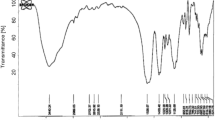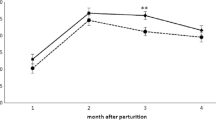Abstract
Supplying dietary zinc in excess of traditional requirements has clear impacts on the gut epithelium, but little research has explored whether similar impacts on the mammary epithelium may occur. Our objective was to determine the effects of supplemental Zn sources, in excess of minimal requirements, on markers of mammary epithelial integrity in blood and in milk as well as the heat stability of milk in mid-lactation cows. Twelve multiparous Holstein cows (132 ± 21 days in milk and 51 ± 3 kg/day milk) were blocked according to milk yield and enrolled in a replicated 3 × 3 Latin square experiment. Experimental periods were 21 days, with 17 days allowed for diet adaptation and 4 days for sampling. Treatment sequences were randomly assigned to animals and treatments were as follows: (1) 0.97 g Zn/day provided as ZnSO4 (34.5 mg supplemental Zn/kg diet DM; 30-ZS), (2) 1.64 g Zn/day provided as ZnSO4 (56.5 mg supplemental Zn/kg diet DM; 60-ZS), and (3) 0.55 g Zn/day provided as ZnSO4 plus 1.13 g Zn/day provided as a zinc-methionine complex (58.2 mg supplemental Zn/kg diet DM; 60-ZM). Treatments were administered once daily as an oral bolus containing all supplemental trace minerals. Rumen-bypass methionine was also included in the 30-ZS and 60-ZS boluses to provide metabolizable methionine equivalent to that provided in 60-ZM rations. Milk samples were assessed for electrolytes, somatic cell transcript abundance of genes related to zinc metabolism, and heat coagulation time. Whole blood samples were analyzed for Na and K concentrations, and plasma samples were analyzed for lactose concentration. Cows fed 60-ZS or 60-ZM had greater zinc intake compared to 30-ZS. Dry matter intake and milk fat content tended to be greater in 60-ZS and 60-ZM cows compared to 30-ZS. Somatic cell linear score was similar among treatments. Treatments neither affected markers of mammary epithelial integrity in blood nor in milk of cows, including plasma concentration of lactose, milk concentrations of Na+ and K+, and SLC30A2 and CLU transcript abundance. Treatments had no effect on milk N fractions or heat coagulation time. This study provided no evidence that supplemental Zn above the established requirements can improve blood-milk epithelial barrier or heat stability of milk in healthy mid-lactation dairy cows.
Similar content being viewed by others
References
NRC (2001) Nutrient requirements of dairy cattle, 7th rev. edn. Natl. Acad. Press, Washington, DC
Andreini C, Banci L, Bertini I, Rosato A (2006) Counting the zinc-proteins encoded in the human genome. J Proteome Res 5:196–201
Spears JW (1996) Organic trace minerals in ruminant nutrition. Anim Feed Sci Technol 58:151–163
Andrieu S (2008) Is there a role for organic trace element supplements in transition cow health? The Vet J 176:77–83
Formigoni A, Parisini P, Corradi F (1993) The use of amino acid chelates in high production milk cows. In: Ashmead HD (ed) The roles of amino acid chelates in animal nutrition, Noyes Publ., Park Ridge, NJ, pp 170–186
Predieri G, Elviri L, Tegoni M, Zagnoni I, Cinti E, Biagi G, Ferruzza S, Leonardi G (2005) Metal chelates of 2-hydroxy-4-methylthiobutanoic acid in animal feeding. Part 2: further characterizations, in vitro and in vivo investigations. J Inorg Biochem 99:627–636
Nayeri A, Upah NC, Sucu E, Sanz-Fernandez MV, De Frain JM, Gorden PJ, Baumgard LH (2014) Effect of the ratio of zinc amino acid complex to zinc sulfate on the performance of Holstein cows. J Dairy Sci 97:4392–4404
Kellog DW, Tomlinson DJ, Socha MT, Johnson AB (2004) Review: effects of zinc methionine complex on milk production and somatic cell count of dairy cows: twelve-trial summary. Prof Anim Sci 20:295–301
Alimohamady R, Aliarabi H, Bruckmaier RM, Christensen RG (2018) Effect of different sources of supplemental zinc on performance, digestibility, and antioxidant enzyme activities in lambs. Biol Trace Elem Res (in press). DOI: https://doi.org/10.1007/s12011-018-1448-1
Miyoshi Y, Tanabe S, Suzuki T (2016) Cellular zinc is required for intestinal epithelial barrier maintenance via the regulation of claudin-3 and occludin expression. Am J Physiol Gastrointest Liver Physiol 311:G105–G116
Dempsey C, McCormick NH, Croxford TP, Seo YA, Grider A, Kelleher SL (2012) Marginal maternal zinc deficiency in lactating mice reduces secretory capacity and alters milk composition. J Nutr 142:655–660
Blackeborough P, Salter DN, Gurr MI (1983) Zinc binding in cow’s milk and human milk. Biochem J 209:505–512
Singh H, Flynn A, Fox PF (1989) Zinc binding in bovine milk. J Dairy Res 56:249–263
Davies DT, White JCD (1966) The stability of milk protein to heat. 1. Subjective measurement of heat stability of milk. J Dairy Res 33:66–81
Kleyn DH, Trout JR (1984) Enzymatic-ultraviolet method for measuring lactose in milk: collaborative study. J Assoc Off Anal Chem 67:637–640
AOAC International (2016) Official methods of analysis. 20th ed. AOAC Int., Gaithersburg, MD
Hillerton JE (1999) Redefining mastitis based on somatic cell count. Int Dairy Fed Bull 245:4–6
Weiss WP (2017) Recommendations for trace minerals for dairy cows. Proc. Cornell Herd Health and Nutrition Conference. Cornell University, Ithaca, NY. pp. 66–75
Wedekind KJ, Hortin AE, Baker DH (1992) Methodology for assessing zinc bioavailability: efficacy estimates for zin-methionine, zinc sulfate and zinc oxide. J Anim Sci 70:178–187
Nockels CF, DeBonis J, Torrent J (1993) Stress induction affects copper and zinc balance in calves fed organic and inorganic copper and zinc sources. J Anim Sci 71:2539–2545
Suttle NF (2010) Mineral nutrition of livestock, 4th edn. CAB International, Oxford, UK
Kuhn NJ, Linzell JL (1970) Measurement of the quantity of lactose passing into mammary venous plasma and lymph in goats and in a cow. J Dairy Res 37:203–208
Stelwagen K, Farr VC, McFadden HA, Prosser CG, Davis SR (1997) Time course of milk accumulation-induced opening of mammary tight junctions, and blood clearance of milk components. Am J Phys 273:R379–R386
Weng X, Monteiro APA, Guo J, Li C, Orellana RM, Martins TN, Bernard JK, Tomlinson DJ, DeFrain JM, Wohlgemuth SE, Tao S (2018) Effects of heat stress and dietary zinc source on performance and mammary epithelial integrity of lactating dairy cows. J Dairy Sci 101:2617–2630
Herve L, Quesnel H, Lollivier V, Portanguen J, Bruckmaier RM, Boutinaud M (2017) Mammary epithelium disruption and mammary epithelial cell exfoliation during milking in dairy cows. J Dairy Sci 100:9824–9834
Laity JH, Lee BM, Wright PE (2001) Zinc finger proteins: new insights into structural and functional diversity. Curr Opin Struct Biol 11:39–46
Canovas A, Rincon G, Bevilacqua C, Islas-Trejo A, Brenaut P, Hovey RC, Boutinaud M, Morgenthaler C, VanKlompenberg MK, Martin P, Medrano JF (2014) Comparison of five different RNA sources to examine the lactating bovine mammary gland transcriptome using RNA-sequencing. Sci Rep 4:1–7
Lopez V, Kelleher SL (2009) Zinc transporter-2 (ZnT2) variants are localized to distinct subcellular compartments and functionally transport zinc. Biochem J 422:43–59
Chowanadisai W, Lönnerdal B, Kelleher SL (2006) Identification of a mutation in SLC30A2 (ZnT-2) in women with low milk zinc concentration that results in transient neonatal zinc deficiency. J Bio Chem 281:39699–39707
Hennigar SR, Seo YA, Shama S, Soybeal DI, Kelleher S (2015) ZnT2 is a critical mediator of lysosomal-mediated cell death during early mammary gland involution. Sci Report 26:8033
Singh K, Davis SR, Dobson JM, Molenaar AJ, Wheeler TT, Prosser CG, Farr VC, Odeh K, Swanson KM, Phyn CVC, Hyndman DL, Wilson T, Henderson HV (2008) cDNA microarray analysis reveals that antioxidant and immune genes are upregulated during involution of the bovine mammary gland. J Dairy Sci 91:2236–2246
French LA, Soriano JV, Montesano R, Pepper MS (1996) Modulation of clusterin gene expression in the rat mammary gland during pregnancy, lactation, and involution. Biol Reprod 55:1213–1220
Sorensen BA, Muir DD, Knight CH (2001) Thrice-daily milking throughout lactation maintains epithelial integrity and thereby improves milk protein quality. J Dairy Res 68:15–25
Auldist MJ, Coats S, Rogers GL, McDowell GH (1995) Changes in the composition of milk from healthy and mastitic dairy cows during the lactation cycle. Aust J Exp Agric 35:427–436
Auldist MJ, Hubble IB (1998) Effects of mastitis on raw milk and dairy products. Aust J Dairy Technol 53:28–36
Sobhanirad S, Carlson D, Kashani RB (2010) Effect of zinc methionine or zinc sulfate on milk production and composition of milk in lactating dairy cows. Biol Trace Elem Res 136:48–54
Wang RL, Liang JG, Lu L, Zhang LY, Li SF, Luo XG (2013) Effect of zinc source on performance, zinc status, immune response, and rumen fermentation of lactating cows. Biol Trace Elem Res 152:16–24
Rabiee AR, Lean IJ, Stevenson MA, Socha MT (2010) Effects of feeding organic trace minerals on milk production and reproductive performance in lactating dairy cows: a meta-analysis. J Dairy Sci 93:4239–4251
Ballou MA (2012) Inflammation: role in the etiology and pathophysiology of clinical mastitis in dairy cows. J Anim Sci 90:1466–1478
Tian H, Zheng N, Wang W, Cheng J, Li S, Zhang Y, Wang J (2016) Integrated metabolomics study of the milk of heat-stressed lactating dairy cows. Sci Rep 6:1–10
Baumgard LH, Rhoads RP (2012) Ruminant production and metabolic responses to heat stress. J Anim Sci 90:1855–1865
Singh H (2004) Heat stability of milk. Int Dairy Technol 57:111–119
Grieve PA, Kitchen BJ (1985) Proteolysis in milk: the significance of proteinases originating from milk leukocytes and a comparison of the action of leukocytes, bacterial and natural milk proteinases on casein. J Dairy Res 52:101–112
Caffin JP, Poutrel B, Rainard P (1983) Physiological and pathological factors influencing bovine immunoglobulin G, concentration in milk. J Dairy Sci 66:2161–2166
Poutrel B, Caffin JP, Rainard P (1983) Physiological and pathological factors influencing bovine serum albumin content of milk. J Dairy Sci 66:535–541
Pechová A, Pavlata L, Lokajová E (2006) Zinc supplementation and somatic cell count in milk of dairy cows. Acta Vet Brno 75:355–361
Gaucheron F (2005) The minerals of milk. Reprod Nutr Dev 45:473–483
Philippe M, Gaucheron F, Le Graët Y, Michael F, Garem A (2003) Physicochemical characterization of calcium-supplemented skim milk. Lait 83:45–59
Acknowledgements
Contribution no. 18-514-J from the Kansas Agricultural Experiment Station. The authors would also like to thank Mike Scheffel and employees of the Kansas State University Dairy Teaching and Research Center (Manhattan, KS) for their assistance in completing this study.
Funding
This research was partially funded by the Zinpro Corporation (Eden Prairie, MN).
Author information
Authors and Affiliations
Corresponding author
Ethics declarations
All experimental procedures were carried out under the Kansas State University Institutional Animal Care and Use Committee approval.
Conflict of Interest
The authors declare that they have no conflict of interest.
Rights and permissions
About this article
Cite this article
Shaffer, J.E., Mamedova, L.K., DeFrain, J.M. et al. Dietary Zinc-Amino Acid Complex Does Not Affect Markers of Mammary Epithelial Integrity or Heat Stability of Milk in Mid-Lactating Cows. Biol Trace Elem Res 190, 349–357 (2019). https://doi.org/10.1007/s12011-018-1556-y
Received:
Accepted:
Published:
Issue Date:
DOI: https://doi.org/10.1007/s12011-018-1556-y




